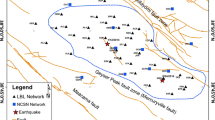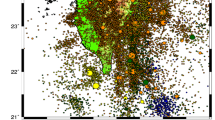Abstract
We examined forecasting quiescence and activation models to obtain the conditional probability that a large earthquake will occur in a specific time period on different scales in Taiwan. The basic idea of the quiescence and activation models is to use earthquakes that have magnitudes larger than the completeness magnitude to compute the expected properties of large earthquakes. We calculated the probability time series for the whole Taiwan region and for three subareas of Taiwan—the western, eastern, and northeastern Taiwan regions—using 40 years of data from the Central Weather Bureau catalog. In the probability time series for the eastern and northeastern Taiwan regions, a high probability value is usually yielded in cluster events such as events with foreshocks and events that all occur in a short time period. In addition to the time series, we produced probability maps by calculating the conditional probability for every grid point at the time just before a large earthquake. The probability maps show that high probability values are yielded around the epicenter before a large earthquake. The receiver operating characteristic (ROC) curves of the probability maps demonstrate that the probability maps are not random forecasts, but also suggest that lowering the magnitude of a forecasted large earthquake may not improve the forecast method itself. From both the probability time series and probability maps, it can be observed that the probability obtained from the quiescence model increases before a large earthquake and the probability obtained from the activation model increases as the large earthquakes occur. The results lead us to conclude that the quiescence model has better forecast potential than the activation model.








Similar content being viewed by others
References
Ben-Zion, Y., and Lyakhovsky, V. (2002), Accelerated Seismic Release and Related Aspects of Seismicity Patterns on Earthquake Faults, Pure Appl. Geophys. 159, 2385–2412.
Chen, C.C., and Wu, Y.H. (2006), An Improved Region-Time-Length Algorithm Applied to the 1999 Chi-Chi, Taiwan Earthquake, Geophys. J. Int. 166, 1144–1147.
Chen, C.H., Wang, J.P., Wu, Y.M., Chan, C.H., and, Chang, C.H. (2012), A Study of Earthquake Inter-Occurrence Times Distribution Models in Taiwan, Nat. Hazards. 69, 1335–1350.
Console, R., Murru, M., Catalli, F., and Falcone, G. (2007), Real Time Forecasts through an Earthquake Clustering Model Constrained by the Rate-and-State Constitutive Law: Comparison with a Purely Stochastic ETAS Model, Seismol. Res. Lett. 78, 49–56.
Ebeling, C.E., An Introduction to Reliability and Maintainability Engineering, (McGraw-Hill, Boston 1997).
Ferraes, S.G. (2003), The Conditional Probability of Earthquake Occurrence and the Next Large Earthquake in Tokyo, Japan, J. Seismol. 7, 145–153.
Gentili, S. (2010), Distribution of Seismicity before the Larger Earthquakes in Italy in the Time Interval 1994–2004, Pure Appl. Geophys. 167, 933–958.
Green, D.M., and Swets, J.A., Signal Detection Theory and Psychophysics (Wiley, New York 1966).
Gomberg, J., Belardinelli, M.E., Cocco, M., and Reasenberg, P. (2005), Time-Dependent Earthquake Probabilities, J. Geophys. Res. 110, B05S04, doi:10.1029/2004JB003405.
Gunton, J.D., and Droz, M., Introduction to the Theory of Metastable and Unstable States (Springer-Verlag, Berlin 1983).
Gunton, J.D., San Miguel, M., and Sahni, P.S., The dynamics of first order phase transitions, Phase Transitions and Critical Phenomena, (eds. Domb, C., and Lebowitz, J.) (Academic, London 1983) pp. 269–467.
Hainzl, S., Zöller, G., Kurths, J., and Zschau, J. (2000), Seismic Quiescence as an Indicator for Large Earthquakes in a System of Self-Organized Criticality, Geophys. Res. Lett. 27, 597—600.
Huang, Q.H. (2004), Seismicity Pattern Changes Prior to Large Earthquakes-An Approach of the RTL Algorithm, Terr. Atmos. Ocean. Sci. 15, 469—491.
Huang, Q.H. (2008), Seismicity Changes prior to the M S 8.0 Wenchuan Earthquake in Sichuan, China, Geophys. Res. Lett. 35, L23308, doi:10.1029/2008GL036270.
Huang, Q.H., and Ding, X. (2012), Spatiotemporal Variations of Seismic Quiescence prior to the 2011 M 9.0 Tohoku Earthquake Revealed by an Improved Region–Time–Length Algorithm, Bull. Seismol. Soc. Am. 102, 1878–1883.
Klein, W., and Unger, C. (1983), Pseudospinodals, Spinodals and Nucleation, Phys. Rev. B 28, 445–448.
Kossobokov, V.G., Maeda, K., and Uyeda, S. (1999), Precursory Activation of Seismicity in Advance of the Kobe, 1995, M=7.2 Earthquake, Pure Appl. Geophys. 155, 409–423.
Langer, J.S. (1967), Theory of the Condensation Point, Ann. Phys. 41, 108–157.
Ma, S.K., Modern Theory of Critical Phenomena (Benjamin-Cummings, Reading, MA 1974).
NIST/SEMATECH e-Handbook of Statistical Methods, 2010. Available at: http://www.itl.nist.gov/div898/handbook/ (last accessed June 2012).
Obuchowski, N.A. (2003), Receiver Operating Characteristic Curves and Their Use in Radiology, Radiology 229, 3–8.
Ogata, Y. (2004), Seismicity Quiescence and Activation in Western Japan Associated with the 1944 and 1946 Great Earthquakes near the Nankai Trough, J. Geophys. Res. 109, B04305, doi:10.1029/2003JB002634.
Pepe, M.S., The Statistical Evaluation of Medical Tests for Classification and Prediction (Oxford, New York 2003).
Rundle, J.B. (1989), A Physical Model for Earthquakes. 3. Thermodynamical Approach and Its Relation to Nonclassical Theories of Nucleation, J. Geophys. Res. 94, 2839–2855.
Rundle, J.B. (1993), Magnitude-Frequency Relations for Earthquakes Using a Statistical-Mechanical Approach, J. Geophys. Res. 98, 21 943–21 949.
Rundle, J.B., Gross, S., Klein, W., and Turcotte, D.L. (1997), The Statistical Mechanics of Earthquakes, Tectonophysics 277, 147–164.
Rundle, J.B., Holliday, J.R., Yoder, M., Sachs, M.K., Donnellan, A., Turcotte, D.L., Tiampo, K.F., Klein, W., and Kellogg, L.H. (2011), Earthquake Precursors: Activation or Quiescence? Geophys. J. Int. 187, 225–236.
Sammis, C.G., Bowman, D.D., and King, G. (2004), Anomalous Seismicity and Accelerating Moment Release Preceding the 2001 and 2002 Earthquakes in Northern Baja California, Mexico, Pure Appl. Geophys. 161, 2369—2378.
Shcherbakov, R., Yakovlev, G., Turcotte, D.L., and Rundle, J.B. (2005), Model for the Distribution of Aftershock Interoccurrence Times, Phys. Rev. Lett. 95, 218501, doi:10.1103/PhysRevLett.95.218501.
Shyu, J.B.H., Sieh, K., Chen, Y.G., and Liu, C.S. (2005), Neotectonic Architecture of Taiwan and Its Implications for Future Large Earthquakes, J. Geophys. Res. 110, B08402, doi:10.1029/2004JB003251.
Sykes, L.R., and Jaumé, S.C. (1990), Seismic Activity on Neighbouring Faults as a Long-Term Precursor to Large Earthquakes in the San Francisco Bay Area, Nature 348, 595–599.
Tiampo, K.F., Rundle, J.B., McGinnis, S.A., and Klein, W. (2002), Pattern Dynamics and Forecast Methods in Seismically Active Regions, Pure Appl. Geophys. 159, 2429–2467.
Tsai, Y.B., Teng, T.L., Chiu, J.M., and Liu, H.L. (1977), Tectonic Implications of the Seismicity in the Taiwan Region, Mem. Geol. Soc. China 2, 13–41.
Vere-Jones, D. (1995), Forecasting Earthquakes and Earthquake Risk, Int. J. Forecasting 11, 503–538.
Wang, J.H., Chen, K.C., Lee, S.J., Huang, W.G., Wu, Y.H., and Leu, P.L. (2012), The Frequency Distribution of Inter-Event Times of M ≥ 3 Earthquakes in the Taipei Metropolitan Area: 1973–2010, Terr. Atmos. Ocean. Sci. 23, 269–281.
Wiemer, S., and Wyss, M. (1994), Seismic Quiescence before the Landers (M = 7.5) and Big Bear (M = 6.5) 1992 Earthquakes, Bull. Seismol. Soc. Am. 84, 900–916.
Wu, F.T. (1978), Recent Tectonics of Taiwan, J. Phys. Earth 2, S265–S299.
Wu, Y.H., Chen, C.C., and Rundle, J.B. (2008), Precursory Seismic Activation of the Pingtung (Taiwan) Offshore Doublet Earthquakes on 26 December 2006: a Pattern Informatics Analysis, Terr. Atmos. Ocean. Sci., 19, 743—749.
Wu, Y.H., Chen, C.C., and Rundle, J.B. (2011), Precursory Small Earthquake Migration Patterns, Terra Nova, 23, 369–374.
Wu, Y.M., and Chiao, L.Y. (2006), Seismic Quiescence before the 1999 Chi-Chi, Taiwan, M W 7.6 Earthquake, Bull. Seismol. Soc. Am. 96, 321–327.
Wyss, M., Bodin, P., and Habermann, R.E. (1990), Seismic Quiescence at Parkfield: an Independent Indication of an Imminent Earthquake, Nature 345, 426–428.
Wyss, M., Westerhaus, M., Berckhemer, H., and Ates, R. (1995), Precursory Seismic Quiescence in the Mudurnu Valley, North Anatolian Fault Zone, Turkey, Geophys. J. Int. 123, 117–124.
Zweig, M.H., and Campbell, G. (1993), Receiver-Operating Characteristic (ROC) Plots: a Fundamental Evaluation Tool in Clinical Medicine, Clin. Chem. 39, 561–577.
Acknowledgments
The authors would like to express their gratitude to the Central Weather Bureau (CWB) for providing their quality earthquake catalogs and to Chien-Hsin Chang for providing the information about the catalog. The work of Y.-H.W. and C.-C.C. was supported by the National Science Council (ROC) (grant NSC-102-2811-M-008-075) and the Department of Earth Sciences, NCU (ROC).
Author information
Authors and Affiliations
Corresponding author
Rights and permissions
About this article
Cite this article
Wu, YH., Chen, CC. & Li, HC. Conditional Probabilities for Large Events Estimated by Small Earthquake Rate. Pure Appl. Geophys. 173, 183–196 (2016). https://doi.org/10.1007/s00024-014-1019-0
Received:
Revised:
Accepted:
Published:
Issue Date:
DOI: https://doi.org/10.1007/s00024-014-1019-0




